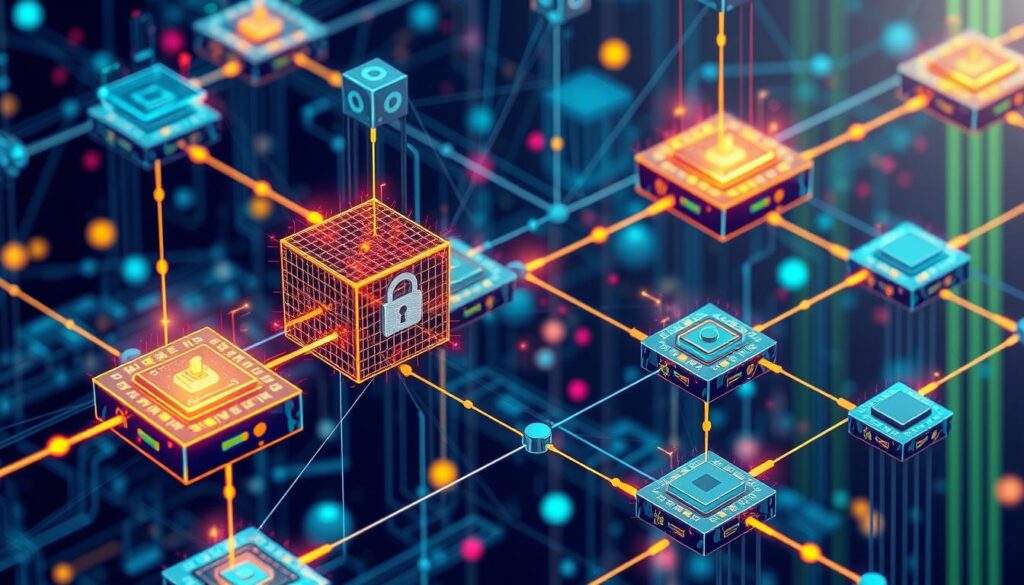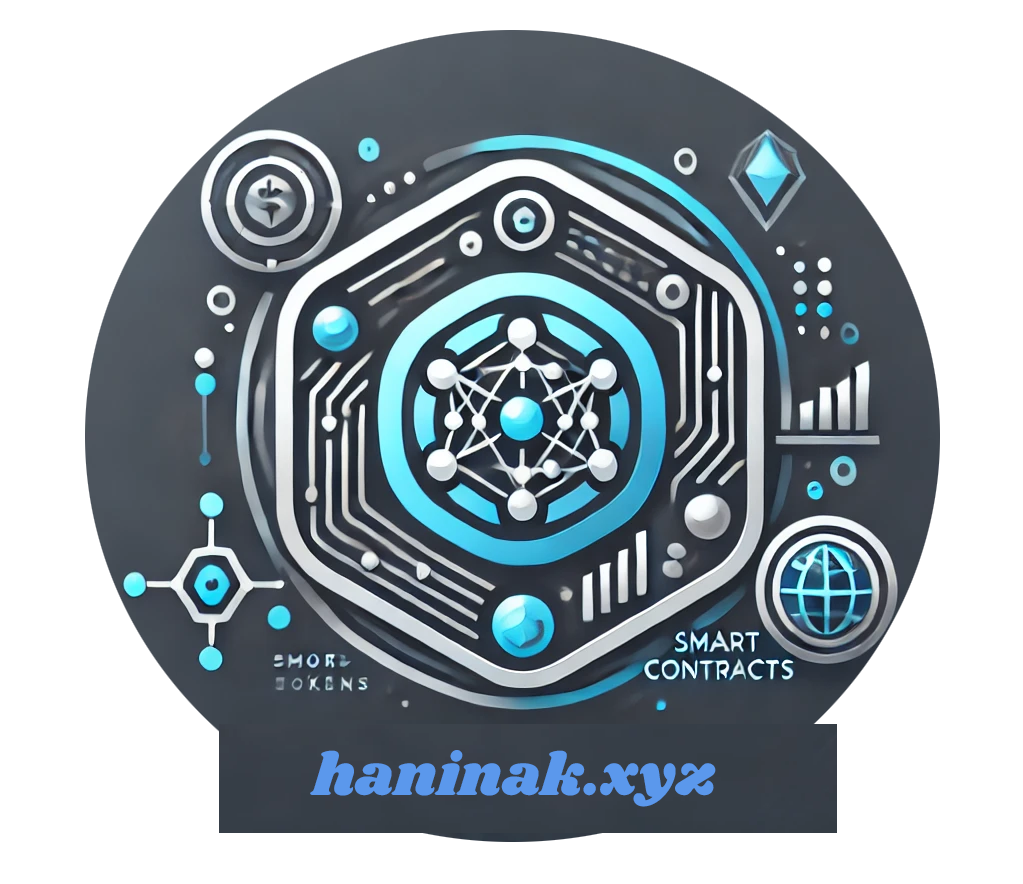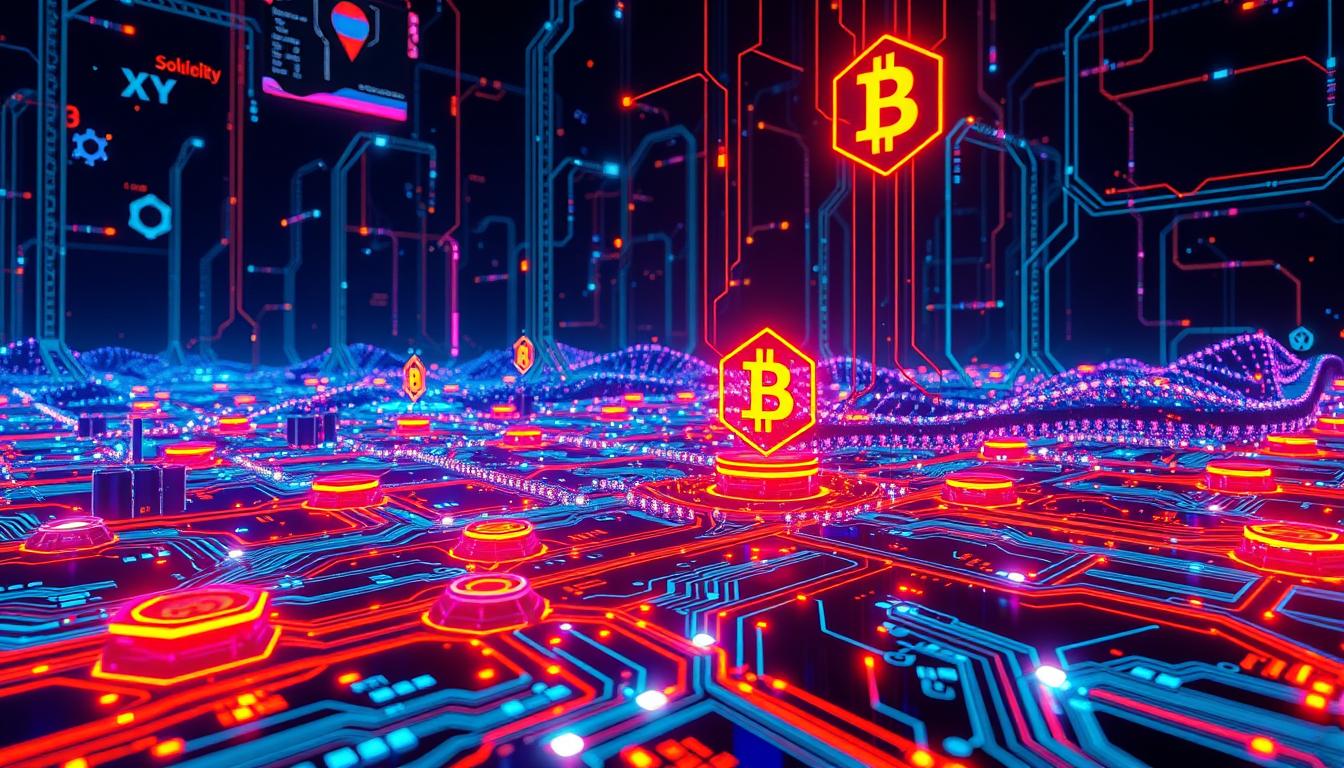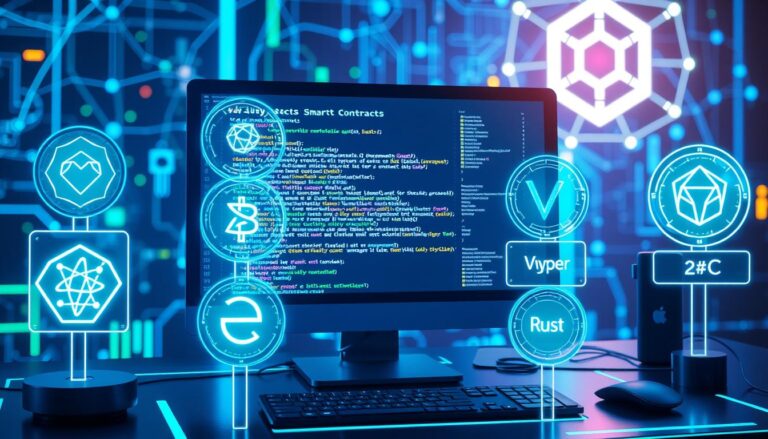What are the main programming languages used for blockchain development?
Blockchain programming started in 2008 with Bitcoin by Satoshi Nakamoto. It’s a public ledger managed by peer-to-peer networking. The demand for blockchain is growing fast, expected to hit $20 billion soon.
Blockchain development uses many programming languages. Each has its own strengths for creating decentralized systems, smart contracts, and cryptocurrencies.
Popular programming languages for blockchain include Solidity, Java, Python, C++, Ruby, Go, and C#. Solidity, influenced by JavaScript, is key for building dApps and ICOs.
Java, based on C-syntax, is chosen for complex smart contracts and dApps. Examples include NEM, IOTA, NEO, and Hyperledger Fabric. Python is liked for its ease of use and is used for dApps and smart contracts, though it can use a lot of memory.
C++ is vital for cryptocurrency development, like Bitcoin, Litecoin, and EOS. It’s known for its structured programming and speed. Ruby, Go, and C# also play important roles in the blockchain world.
Understanding Blockchain Development Fundamentals
Blockchain technology started because people wanted secure, decentralized ways to do transactions. It grew from early work in cryptography, decentralization, and peer-to-peer networks. Now, it’s a key tech changing many industries.
Origins and Evolution of Blockchain Technology
Bitcoin launched in 2009, starting the blockchain journey. It aimed to make a safe, open, and decentralized digital money. Since then, blockchain has grown. It now helps make apps and smart contracts that work on their own.
Key Components of Blockchain Architecture
Blockchain’s heart is its distributed ledgers, consensus methods, and cryptography. The ledger is spread out, making data safe and open. Algorithms like Proof of Work (PoW) or Proof of Stake (PoS) help add new data safely.
Cryptographic tools like hashing and public-key cryptography keep data safe. They link each block to the last, making the blockchain strong.
Role of Smart Contracts in Development
Smart contracts are digital rules that work on their own. They’re key in blockchain, helping make complex apps. These apps can handle things like supply chains and finance.
Blockchain has gotten better over time, becoming faster and more useful. It’s now used in many areas. Developers and companies are finding new ways to use blockchain to innovate and change old systems.

Blockchain Technologies and Techniques: Core Programming Languages
Blockchain development uses many programming languages, each with its own strengths. Solidity, made by Ethereum’s Vitalik Buterin, is key for smart contracts. It’s inspired by C++, Python, and JavaScript.
JavaScript is also popular for blockchain work, especially for web stuff. It’s great for interactive sites and client-side tasks. Proof of Work (PoW) and Proof of Stake (PoS) help keep transactions safe.
Ethereum is favored for its Solidity language and secure platform. The Ethereum Virtual Machine (EVM) is safe for apps. Ether is used for money and “gas” for transactions.
C++ is top for blockchain because of its memory control and multithreading. Python is easy to read and is good for new developers.
The need for blockchain developers is rising, with salaries up to $109,000. Freelancers can earn $81 to $100 an hour. But, only 0.6% of 20 million software developers know blockchain.

Advanced Programming Languages for Smart Contract Development
Blockchain technology keeps growing, giving developers more programming languages for smart contracts. Solidity, Rust, and Go are among the top choices. Each has its own strengths and uses.
Solidity and Ethereum Development
Solidity is key for Ethereum smart contracts. It has features like inheritance and high accuracy. It’s widely used in the crypto world, especially on Ethereum, Ethereum Classic, Polkadot, and Binance Smart Chain.
Rust for High-Performance Blockchain Solutions
Rust is a low-level language known for its speed and safety. It’s used in Polkadot and Solana for fast and efficient blockchain solutions. Rust has been a favorite programming language for five years in a row, according to Stack Overflow Surveys.
Go Language in Modern Blockchain Systems
Go is known for its simplicity and efficiency. It’s used in Cosmos and Hyperledger Fabric. Go lets developers work quickly, making it great for blockchain apps.
These languages help developers make Smart Contracts that are secure, scalable, and fast. They work well with the Ethereum Virtual Machine and other Substrate-based platforms.
Emerging Languages and Frameworks in Blockchain
New programming languages and frameworks are coming to the blockchain world. They meet the needs of this fast-growing tech. These tools open up new possibilities in blockchain development and solve old problems.
WebAssembly, or Wasm, is becoming key in blockchain. It lets developers write code in languages like C, C++, or Rust. Then, it compiles into a format that works on any device with a Wasm-enabled browser or runtime. This makes blockchain apps more portable and fast.
Move is a language for the Libra blockchain (now Diem). It’s all about safe digital asset management. Its special way of programming stops problems like double-spending. This makes it great for apps that need to handle digital assets securely.
Motoko is for the Internet Computer protocol. It makes writing smart contracts easier. Motoko’s high-level, actor-oriented model hides the complex details of blockchain networks. This lets developers focus on the app’s core logic.
These new languages and frameworks are making blockchain programming better. As the blockchain world grows, developers will have more tools to create innovative, safe, and efficient blockchain solutions.
| Language | Key Focus | Adoption |
|---|---|---|
| WebAssembly | Cross-platform compatibility | Growing rapidly, used in various blockchain projects |
| Move | Secure digital asset management | Developed for the Libra/Diem blockchain |
| Motoko | Simplified smart contract development | Created for the Internet Computer protocol |
Conclusion
The blockchain world is always changing, with different ecosystems working together or competing. Choosing the right programming language for Blockchain Development depends on the project and platform. Developers need to keep up with new languages and tools to make secure and efficient blockchain solutions.
Mastering both old and new programming languages is key for the future of Blockchain Development. Blockchain is seen as a major breakthrough after the Internet. Its use is growing faster than expected, changing how we do business and technology.
Despite challenges like high costs and scalability issues, the blockchain industry is set to grow. Developers must stay current with Blockchain Programming Languages to create solutions that will shape its future.







